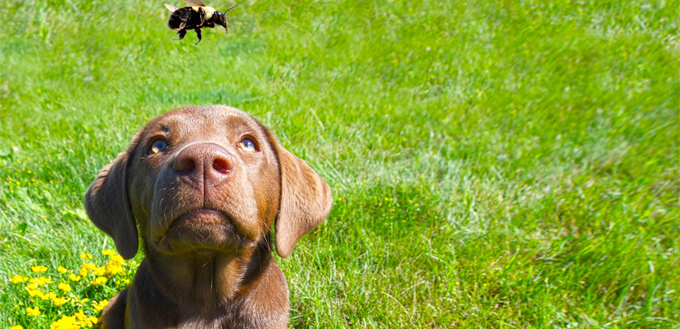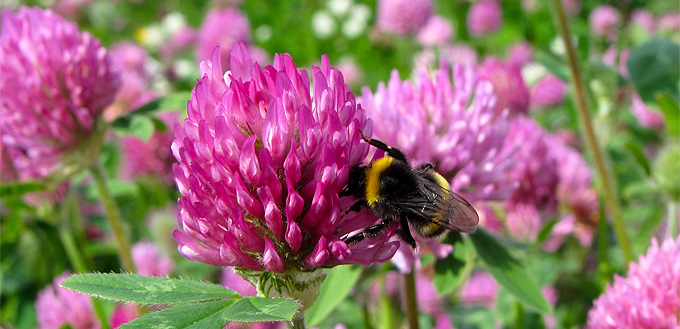Dogs are agile and flexible. They also have great reflexes, especially in the mouth area. How many times have you seen dogs catch treats with their mouth, even if the throw is a little off? Well, that is because of their super reflex.
But sometimes, this great reflex also gets them into trouble.
Mistaking insects for trees, they tend to grab them with their mouth. It is usually ok to grab butterflies and houseflies, but what about wasps and bees? These insects are known for their painful stings and there is always a chance that they can sting your dog’s mouth to defend themselves. To top it, some dogs are allergic to bee stings, and this could further complicate things for the dog as well as for you.
But don’t worry, all is not lost!

Can Dogs Become Sick When They Eat Bees?
The common fear that hits us when we know that our dog has eaten a bee is the sickness that comes with it. So, let’s get one thing straight! Your dog cannot fall sick when it eats a bee, all that you have to worry is the sting that comes from it. There will be no digestion problems whatsoever, and your dog will digest it just like any other food.
Some people fear that bees may inject their venom into their dog and this can cause them to fall sick. First off, bees are not poisonous. They are venomous, but there is no poison. Now, venom and poison are two different things really.
Generally speaking, poisons cause some adverse reaction when they are touched or eaten, but the same can’t be said about venom. Another significant difference is that poison enters the body passively, in the sense, they emanate from the organism or the object containing it, and it enters the bloodstream when that item or organism is digested. When his poison is mixed with blood, it causes severe sickness, and sometimes even death.
Venom, on the other hand, is administered actively, either through a syringe, fangs or even a hair.
For example, there are some mushrooms that are poisonous. So, if you end up touching or eating it, you’re sure to have an adverse reaction, that could sometimes even be fatal. Venoms, on the other hand, cause no such reaction when touched or even digested.
So, all this means, your dog will not fall sick or die when it eats a bee because the venom from the bee has no impact when digested.
How else can it impact your dog? Bee stings are the only problem you’ll face when your dog eats a bee.
How to Care for the Sting?
The symptoms from a sting are usually mild and temporary. In most cases, you’ll see only a mild swelling or localized pain. In a way, this is a good thing for your dog to experience because it will know never to eat a bee or a wasp again.
As a dog owner, there is nothing to worry about as this sting will go away soon. Maybe a few hours, and there will be no sign of the sting on your dog’s body.
Still, there are some things you can do to make your dog feel better.
First off, cuddle with your dog because it probably needs that comfort. As humans, we know that what has stung the dog is a bee, but your dog may not be able to identify it so easily. If it could (hopefully the next time), it is sure to stay away from these insects.
It is your duty to make your dog feel better by providing the right care and comfort. When you cuddle with your dog, it is one way of showing your love and affection and reassuring your dog that you are there for it, regardless of what happens. Secondly, it is sure to give a world of comfort for your dog.
It is similar to what human beings need when they are sick or scared. If you feel sick, you’d sure love to have a bowl of chicken soup from your mother or spouse or someone dearest to you. You would even crave for a hug just to make you feel better. The same applies to your dogs too. So, as a first step spend some time with your dog and cuddle it, just to reassure that everything is fine.
Once the mental part is taken care of, move to the physical side. Remove the bee’s stinger, if it is present. In general, only honeybees leave a stinger behind, and there is no stinger from any other bee or wasp.
If a honeybee has bitten your dog, make sure to scrape out the stinger gently. Never try to pinch or pull it out, as this could aggravate the pain and could even leave a mark. Also, when you pinch or pull, you tend to force more venom into the wound. So, keep the tweezers away, so you don’t need it to pinch. A better way is to use a card, like a credit card maybe, to gently scrape out the stinger. Do not apply too much pressure. Just do it gently. If you can’t get it out with a few strokes, take a break and scrap more out. It is good to have a little bit of patience here, as you can gently take it out without adding more pain and fear to your dog.
Some studies even recommend that you use some baking soda and water to help the stinger to become loose, so you can scrape it out easily, But this has not been verified and we do not know how safe it is for your dog’s skin. So, we would not recommend it, but still, we thought it is good for you to know that some people use this method.
Also, using baking soda could have a different impact based on what has stung your dog. For example, the venom from a bee is acidic in nature, so when you use the baking soda, it will neutralize the effect. On the other hand, the sting from a wasp is acidic, so this means, when you use baking soda, the wound will become worse. So, that’s another thing to keep in mind if you decide to go the baking soda route.
Some people also use apple cider vinegar, but that’s also debatable.
The best option is to simply scrape out the venom, if there is one and apply cool compress on the area where the bee or wasp has stung your dog. This cool compress can bring a lot of relief from the pain and wound, and could even help the area to heal faster. It is also safe, as there is no possibility for any acidic or alkaline reaction.
In short, make sure you cuddle your dog and apply some cold compress to the area. If the sting is from a honeybee or if you see traces of a stinger, gently scrape it out with an old credit card. Do not do anything that makes your dog feel uncomfortable. After a few hours, the pain will subside and the swelling will go down.
The above remedies are most ideal for stings that are minor, at best. If you encounter more serious stings, here is what you should do.

Serious Stings
When your dog has an immediate adverse reaction due to the sting, it simply means your dog has some kind of allergy for bee or wasp venom. So, seek medical help right away.
The most common reaction is breathing difficulty. Your dog will have an anaphylactic reaction in which it will struggle to breathe. Rush your dog to the doctor right away when you see this condition. If you do not seek medical help, there is a possibility for your dog to even die. So, understand the seriousness and get to the nearest medical center.
Now, this brings an important question. How to know if your dog is having an allergic reaction that requires medical attention versus a regular reaction that is harmless and will go away in some time.
Well, the best way is to use your judgment and instincts as you know the dog’s behavior pattern the best.
Also, below are some possible symptoms that could mean your dog is in trouble and needs medical attention right away.
Swelling
If you see swelling in the mouth or nose area, it is serious because it can impede your dog’s ability to breathe. Take your dog to the vet immediately, as they can administer injections that will bring down the swelling or negate the impact of venom if that’s what caused an allergic reaction to the sting.
Breathing Difficulty
Breathing difficulty in any form and at any time warrants medical attention. This is all the more important if your dog begins to breathe heavily after a sting. This is a sure sign of an allergic reaction and it is time to rush your dog right away.
Sleepy or Lack of Coordination
Another critical sign of an allergic reaction is lethargy, sleepiness or lack of coordination. In fact, if you see all the three, it means your dog is having an allergic reaction and a trip to the vet is absolutely important!
Gut Feeling that Something is Wrong
This is definitely a vague symptom, but we are predisposed to understand that something is wrong in us and the ones we love. Maybe it is an instinct that is passed down to us from the hunting and gathering days of our ancestors. Nevertheless, if your gut feeling says that something is not all right with the dog, take it to the hospital right. It is ok if you make an extra trip and the vet confirms that everything is alright. Better be safe than sorry!
Now, let the above symptoms not scare you because that’s not the idea! Keep in mind that most dogs are not allergic to bee stings and will merely experience minor symptoms such as localized pain and a small bit of swelling. This allergy is not specific to any breed. Existing research does not believe that any breed is more predisposed than others to bee stings and the resulting allergies.

Some Things to Keep in Mind
Before we end this discussion, here are some things to keep in mind when it comes to dogs and bee stings.
- If a bee that your dog ate or swallowed stings your dog at the back of its tongue or down the throat, then it is a serious situation even if your dog is not allergic to bee stings. This is because bee stings can cause that area to swell for some time, and in turn, this will obstruct your dog’s airway, thereby causing breathing problems. Understand that this breathing difficulty is not due to an allergic reaction per se, but a normal swelling that has happened because of a sting in the tongue or throat.
- As unfortunate as this may sound, sometimes your dog may end up with multiple stings. This could happen if your dog was trying to catch a hive just out of curiosity! When it has multiple stings, your dog is sure to be in great distress. So keep a close eye out for any untoward symptoms and help your dog to get through this difficult phase with a lot of love and affection.
- If a bee has stung your puppy, keep a close eye on it as well because pups are not as strong as a grown dog, and it may not be able to take that level of pain.
In short, bee stings are not poisonous and they will not cause any problems for your dog while digesting it. But the only problem that could happen is stinging, which the bee is likely to do as a natural defense mechanism. This can cause some allergic reactions in dogs, and just a mild swelling in others. Either way, watch out for these stings and seek medical help if you notice any of the above symptoms.






So we have a lot of lavender bushes in our garden and they attract lots and lots of bees. Our dog is obsessed with insects and spends all day hunting them and eating them. She has learnt to catch them get the sting out and eat them. We constantly try and stop her as we love bees and can’t stand to see so many killed. For the last 3 mornings she has been sick and today when she was sick there must of been at least 20 bees in her vomit. She is well in herself but has been sick. Is this something to be concerned about other than the fact it’s cruel to the bees? Thanks
One paragraph says that both bee & wasp stings are acicic. I think you mean that bees stings are acicic & wasp stings are slkaline. I was confused, & perhaps others were, also.